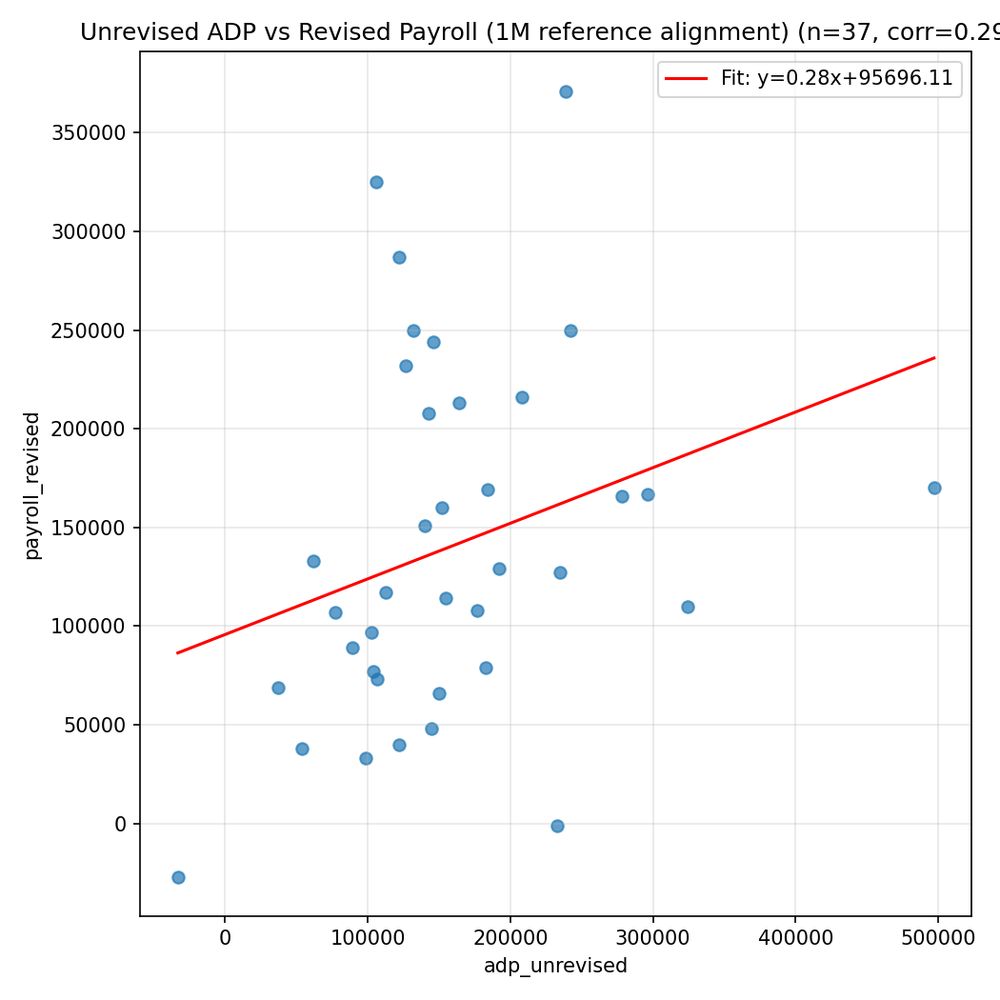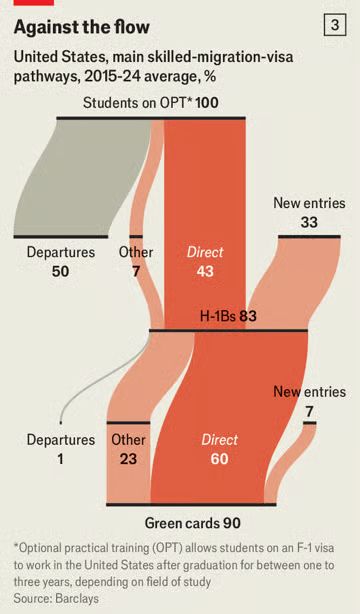Agreed, DMP work was fascinating
13.11.2025 18:27 — 👍 1 🔁 0 💬 0 📌 0

Synthetic controls with a heavy weight on the US always worry me a little, but this is a careful bit of work from Nick Bloom and co with (as I see it) two big implications
1. They put the Brexit hit to GDP at 6-8%..!
2. Their measure of the damage hasn't bottomed out yet
www.nber.org/papers/w34459
13.11.2025 18:12 — 👍 7 🔁 5 💬 2 📌 1
www.economist.com/leaders/200...
11.11.2025 16:34 — 👍 0 🔁 0 💬 0 📌 0

From an Economist leader in August 2000
11.11.2025 16:34 — 👍 10 🔁 5 💬 1 📌 0
We're fortunate, then, that the shutdown looks like it's ending and that the attacks on the independence of the BLS have diminished. No substitute for government data quite yet.
Here's the link to the full piece again: www.economist.com/finance-and...
10.11.2025 18:01 — 👍 2 🔁 0 💬 0 📌 0


That chart above is also a comparatively generous perspective. Zoom in on the one-month level (i.e. release-to-release) and initial ADP prints are pretty much entirely uncorrelated with initial private payrolls prints (and somewhat, but not vastly, correlated with final prints).
10.11.2025 18:01 — 👍 2 🔁 0 💬 1 📌 0

Another issue is that private-sector data tends to benchmark itself heavily to the official stuff.
That means even the better sources, like ADP's payrolls measure, look a lot worse when you look at the actual initial releases, not the final revisions.
10.11.2025 18:01 — 👍 0 🔁 0 💬 1 📌 0
A bit more on one paper that does a more rigorous job than my chart in teasing that all out
x.com/ArchieHall/...
10.11.2025 18:01 — 👍 0 🔁 0 💬 1 📌 0

One simply proxy for whether government data still matters is whether it moves markets. Over the past few years, government data has been more market-moving that ever.
10.11.2025 18:01 — 👍 0 🔁 0 💬 1 📌 0

The trouble is that even in places with plenty of solid alternatives (like payrolls), they rarely agree.
Further down, a very quick 🧵 with a few more highlights.
10.11.2025 18:01 — 👍 0 🔁 0 💬 1 📌 0
As the shutdown grinds to an end, I took stock for @economist.com on how well private-sector data has done guiding America through the past few months' data drought.
www.economist.com/finance-and...
10.11.2025 18:01 — 👍 4 🔁 3 💬 2 📌 0
A quick take from me ahead of tomorrow’s Supreme Court arguments on IEEPA tariffs
— There are lots of non-IEEPA authorities Trump can use rebuild his tariff wall
— But, losing IEEPA will make the tariff-setting process more lumbering and chaotic. That could be a problem
economist.com/finance-and...
04.11.2025 17:46 — 👍 6 🔁 1 💬 1 📌 0

Nigel Farage’s economic plans are a disaster
Three choices: fiscal implosion, deep austerity or a hasty U-turn
Farage's jettisoning of the 2024 manifesto in favour of what promises to be a much more fiscally-conservative approach is a significant moment. My colleague @archiehall.bsky.social ran the rule over the policybook as late as May. It wasn't pretty. www.economist.com/britain/2025...
03.11.2025 11:03 — 👍 18 🔁 3 💬 1 📌 2
Striking, though, that you don’t see this in America (at least in the survey data, anecdotally you get lots of the same complaints) — or in 2023/4 when inflation expectations seemed to be coming down
02.11.2025 21:30 — 👍 0 🔁 0 💬 1 📌 0

Here's something I don't have a good explanation for— British households' long-run inflation expectations are pretty severely de-anchored, but markets are totally relaxed.
02.11.2025 16:10 — 👍 4 🔁 0 💬 3 📌 0

Have data centres raised power bills? Not really, our analysis @economist.com finds—at least so far. Adding data centres to a state-level model of electricity prices shows no significant effect
But backlash is brewing. My latest, on the politics of the data centre: www.economist.com/united-state...
30.10.2025 15:22 — 👍 10 🔁 2 💬 0 📌 1
And a dispatch from @dlknowles.bsky.social from the ICE raids in Chicago www.economist.com/united-stat...
07.10.2025 20:42 — 👍 6 🔁 0 💬 0 📌 0
11/ So at least for now, Zero Migration America is here to stay. Best start getting used to it.
Here's the piece again: www.economist.com/finance-and...
07.10.2025 20:42 — 👍 13 🔁 0 💬 2 📌 0
10/ But: even unpopular Trump policies have a habit of sticking around. And there's little indication the administration has much desire to slow down.
Business complaints, even in industries with effective lobbying operations, so far haven't done much.
07.10.2025 20:42 — 👍 9 🔁 0 💬 1 📌 0

9/ The $100k H1-B fee also polls terribly: 57% of Americans opposite it, only 26% support it. Even among Republicans it's barely above water.
07.10.2025 20:42 — 👍 11 🔁 0 💬 1 📌 0

8/ Will the policy stick?
Public opinion on migration has rebounded sharply upward this year. 79% of Americans now thing immigration is good for the country, the highest on record.
07.10.2025 20:42 — 👍 10 🔁 0 💬 1 📌 0

7/ ... its issues with an aging workforce, especially if what we're seeing today sticks.
07.10.2025 20:42 — 👍 11 🔁 0 💬 1 📌 0

6/ Zero Migration also worsens America's deficit problems, and...
07.10.2025 20:42 — 👍 10 🔁 1 💬 1 📌 0

5/ The hit to growth from a serious attempt to squeeze skilled migration would be pretty stark.
07.10.2025 20:42 — 👍 10 🔁 0 💬 1 📌 0

4/ But the more consequential story is long-term.
The H1-B fee mess showed a fairly clear direction of travel on the Trump admin's desire to pull down skilled migration. The next place to watch is OPT, the post-grad work status that gets most talented foreigners into the US.
07.10.2025 20:42 — 👍 10 🔁 0 💬 1 📌 0
3/ Short-term, this will clearly be vastly disruptive.
— Plenty of industries like construction and farming lean very heavily on immigrant workers.
— High migration helped enable the 'soft landing' in 2023/4, by absorbing outsize labour demand. We could now see the reverse.
07.10.2025 20:42 — 👍 9 🔁 1 💬 1 📌 0

2/ What's happened? Crossings at the southern border have crashed after Trump's asylum ban.
Deportations are up and skilled-worker visa are already creeping down (even before talk of the $100k H1-B fee).
That is a stark reversal: net migration was ~2-3m in 2023 and 2024.
07.10.2025 20:42 — 👍 9 🔁 0 💬 1 📌 0

For the first time in about 70 years, net immigration to America could be zero. Beneath the noise of tariff and budget fights, migration may well be the biggest economic story of 2025.
My latest for @economist.com: Welcome to Zero Migration America
Link: www.economist.com/finance-and...
🧵 below
07.10.2025 20:42 — 👍 71 🔁 30 💬 5 📌 3
Partnerships for News & Business/Finance @ Bluesky
EM macro watcher
«not a value judgement»
Day job: climate change, heat pumps, energy at Nesta
Other stuff: low-fi economics on growth, cities & economic geography, general UK policy, occasional basic charts
Bristol, he/him, lots of parenting / caring.
Personal account.
Programme Director at @instituteforgovernment.org.uk working on public services
Northern Ireland Editor of the Belfast Telegraph & Sunday Independent. Author of Burned: The Inside Story of the Cash-for-Ash Scandal. Any views mine alone.
Journalist at The Economist
Chief Executive, Resolution Foundation
Former economist and civil servant. Former (age related) national cycling champion. Still a music fan. Sewn up member of the Zipper Club.
I’m a historian of the seventeenth-century Caribbean. I write about religion and slavery, and occasionally about emotions.
Deputy Chief Economist @instituteforgov.bsky.social
On Twitter @tompope0
Econ person. Director of Policy and Research, @economicsecurityproject.org. Former NEC. #Rstats, dad, Chicago Guy. mikekonczal.com
Home of the "Best of #Econtwitter" (& #econsky) newsletter
https://www.bestofecontwitter.com/
Fellow at the Center for Global Development, author of Getting Better and The Plague Cycle. (CGD doesn't have institutional positions, so don't blame it for mine).
Conservation biologist and behavioural ecologist. Treasurer of Scientists for Labour. Postdoc at @durhamanthropology.bsky.social, DPhil from @biology.ox.ac.uk
At Resolution Foundation covering labour market, low pay, living wage.
Head of Health at the IPPR
Bourgeois interests, proletarian instincts.
Academic history journal, publishing in all fields and periods.
Find our content here:
https://academic.oup.com/ehr
Author of Default: The Landmark Court Battle over Argentina’s $100 Billion Debt Restructuring





















